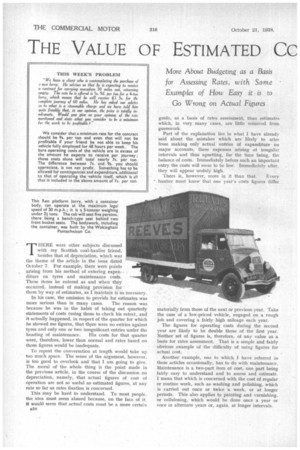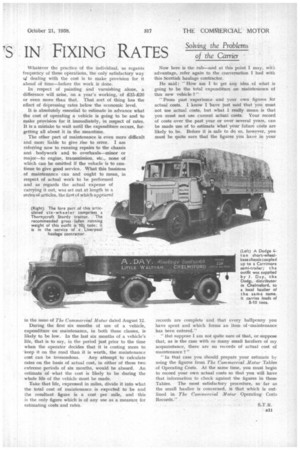THE VALUE OF ESTIMATED CC 'S IN FIX1N
Page 44

Page 45

If you've noticed an error in this article please click here to report it so we can fix it.
G RATES Solving the Problems of the Carrier •
More About Budgeting as a Basis for Assessing Rates, with Some Examples of How Easy it is to Go Wrong on Actual Figures
THERE were other subjects discussed with my Scottish coal-haulier friend, besides that of depreciation, which was the theme of the article in the issue dated October 7. For example, there were points arising from his method of entering expenditure on tyres and maintenance costs. These items he entered as and when they occurred, instead of making provision for them by way of estimates, as I maintain is so necessary.
In his case, the omission to provide for estimates was
more serious than in many cases. The reason was because he was in the habit of taking out quarterly statements of costs (using those to check his rates), and it actually happened, in respect of the quarter for which he showed me figures, that there were no entries against tyres and only one or two insignificant entries under the heading of maintenance. His costs for that quarter were, therefore, lower than normal and rates based on those figures would be inadequate.
To repeat the conversation at length would take up too much space. The sense of the argument, however, is too good to overlook and that I am going to give. The moral of the whole thing is the point made in the previous article, in the course of the discussion on depreciation, namely, that actual figures of cost of
operation are not so useful as estimated figures, at any rate so far as rates fixation is concerned.
This may be hard to understand. To most people. the idea must seem absurd because, on the face of it. it would seem that actual costs must be a more certain
a10
guide, as a basis of rates assessment, than estimates which, in very many -cases, are little removed from guesswork.
Part of the explanation lies in what I have already said about the mistakes which are likely to arise from making only actual entries of expenditure on major accounts, these expenses arising at irregular intervals and thus upsetting, for the time being, the balance of costs. Immediately before such an important entry. the costs will seem to be low. Immediately after, they will appear unduly high.
There is, however, more in it than that. Every haulier must know that one year's costs figures differ materially from those of the next or previous year. Take the case of a low-priced vehicle, engaged on a rough job and covering a fairly high mileage each year.
The figures for operating costs during the second year are likely to be double those of the first year. Neither set of figures is, therefore, of any value as a basis for rates assessment. That is a simple and fairly obvious example of the difficulty of using figures for actual cost. •
Another example, one to which I have referred in these articles occasionally, has to do with maintenance. Maintenance is a two-part item of cost, one part being fairly easy to understand and to assess and estimate. I mean that which is concerned with the cost of regular or routine work, such as washing and polishing, which is carried out once or twice a week, or at longer periods. This also applies to painting and varnishing, or cellulosing, which would be done once a year or once in alternate years or, again, at longer intervals.
Whatever the practice of the individual, as rcgarcis frequency of these operations, the only satisfactory way of dealing with the cost is to make provision for it ahead Of tirribefore the work is done.
In respect of painting and varnishing alone, a
difference will arise, on a year's working, of 415-224 or even more than that. That sort of thing has the
effect of depressing rates below the economic level.
It is absolutely essential to estimate in advance what the cost of operating a vehicle is going to be and to make provision for it immediately, in respect of rates. It is a mistake to wait until the expenditure occurs, forgetting all about it in the meantime.
The other part of maintenance is even more difficult
and more liable to give rise to error. I am referring now to running repairs to the chassis and bodywork and to overhauls—minor or
major—to engine, transmission, etc., none of which can be omitted if the vehicle is to continue to give good service. What this business of maintenance can and ought to mean, in respect of actual work to be performed and as regards the actual expense of carrying it out, was set out at length in a series of articles, the first of which appeared
in the issue of Tie Co-Inmercial Motor dated August 12.
During the first six months of use of a vehicle, expenditure on maintenance, in both these classes, is likely to be low. In the last six months of a vehicle's life, that is to say, in the period just prior to the time when the operator decides that it is costing more to keep it on the road than it is worth, the maintenance
cost can be tremendous. Any attempt to calculate rates on the basis of actual cost, in either of these two extreme periods of six months, would be absurd. An estimate of what the cost is likely to be during the whole life of the vehicle must be made.
Take that life, expressed in miles, divide it into what the total cost of maintenance is expected to be and the resultant. figure is a cost per mile, and this is the only figure which is of any use as a measure for estimating costs and rates.
Now here is the rub—and at this point I may, with advantage, refer again to the conversation I had with this Scottish haulage contractor.
He said: "How am I to get any idea of what is going to be the total expenditure on maintenance of this new vehicle ?"
" From past experience and your own figures for actual costs. I know I have just said that you must not use actual costs, but what I really mean is that you must not use current actual costs. Your record of costs over the past year or over several years, can be made use of to estimate what your future coils are likely to be. Before it is safe to do so, however, you must be quite sure that the figures you have in your records are complete and that every halfpenny you have spent and which forms an item of -maintenance has been entered."
" But suppose I am not quite sure of that, or-suppose that, as is the case with so many small hauliers of my acquaintance, there are no records of actual cost of maintenance ? "
"in that case you should prepare your estimate by using the figures from The Commercial Motor Tables of Operating Costs. At the same time, you must begin to record your own actual costs so that you will have that information to check against the figures in those Tables. The most satisfactory procedure, so far as the small haulier is concerned, is that which is outlined in The Commercial Motor Operating Costs Records."
S.T.R. all




























































































